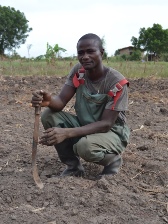 School meals can do more than just feed children
School meals can do more than just feed children
Each year on 16 October World Food Day aims to increase understanding of problems and solutions in the drive to end hunger, malnutrition and poverty. Over the years the day has taken on various themes which have focused on investing in agriculture and recently focus has been drawn on health and education too.
One solution which countries have put in place to combat hunger and poverty is to provide free school meals to their schoolchildren, and now an increasing number of governments are looking at how school feeding can do the same for their smallholder farmers.
Globally the scale of school feeding is massive. The State of School Feeding Worldwide a ground breaking report published earlier this year by the UN’s World Food Programme and World Bank with support from Imperial College London’s Partnership for Child Development (PCD), found that governments in 169 countries are investing up to $75 billion dollars annually to provide school meals to over 368 million children every school day.
The popularity of school feeding is simply that it gets results - results in terms of happier, healthier and better educated kids. The evidence base shows that school feeding increases pupil enrolment, improves retention and that educational outcomes improve as children are able to concentrate better and ultimately enter adult life well equipped. These benefits are felt the most in the poorest communities. In short school feeding provides a very effective social safety net.
Increasingly countries are beginning to realise that school feeding can do more than just benefit school children. By procuring their food locally school feeding programmes can support marginalised smallholder farmers by providing them with a constant stable market to sell to; increasing profits for smallholder farmers whilst at the same time providing fresh and nutritious local food to school meals. These Home Grown School Feeding (HGSF) programmes have the potential to build strong rural economies by creating jobs and profits not only for smallholder farmers, but also for a wide range of stakeholders involved in getting the food from the field to the classroom.
In 2003 the HGSF baton was picked up by the New Partnership for Africa's Development (NEPAD) of the African Union which launched a pilot HGSF and Health Programme. That same year, African governments included locally sourced school feeding programmes in NEPAD's Comprehensive Africa Agriculture Development Programme (CAADP).
In Africa there has been substantial adoption of the concept with government HGSF programmes of one design or another, created in Botswana, Cape Verde, Ethiopia, Kenya, Mali, Namibia, Nigeria, Rwanda, South Africa and Tanzania.
A leading champion of the HGSF approach is Ghana. Eight years ago former Ghanaian President and World Food Prize Laureate, H.E. John Kufuor launched Ghana’s School Feeding Programme (GSFP) as an initiative to improve food security, increase in school enrolment and reduce poverty. From a pilot programme of just 10 schools, its popularity has seen successive governments expand the GSFP to feed over 1.6 million children from across 4900 schools. In that time Ghana became first sub-Saharan African country to half the number of people living on less than a dollar a day.
A beneficiary of the GSFP is Jacob Mechi, a smallholder farmer who works in Kwabenya-Atomic area of Accra, Ghana. He explains, “The programme is very good for me because I can sell my crop direct from my farm without having to spend extra money on transporting it to market… I am proud that it is my produce that is being used to feed the schoolchildren.”
There are still important knowledge gaps which have to be addressed to ensure safe, effective and sustainable programmes. As highlighted by the tragic deaths of 22 children in Bihar, India in 2013, there is a need to continue to improve the standards and quality of global school feeding systems.
Further research is also being conducted to fully understand how to best design these programmes so that they maximise the benefits felt by all people who make up the school feeding supply chain, from the farmer on their smallholding, to the processor in their mill, to the child sat in their classroom.
This year’s World Food Day theme is, “Sustainable Systems for Food Security and Nutrition”, and when HGSF is effectively implemented it can be just that - a sustainable structure to combat food security and nutrition and one which is a win-win for children and farmers alike.
Article by Charlotte Broyd and Francis Peel, Partnership for Child Development, Imperial College London.





